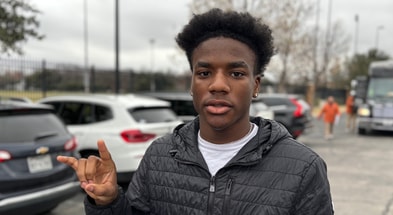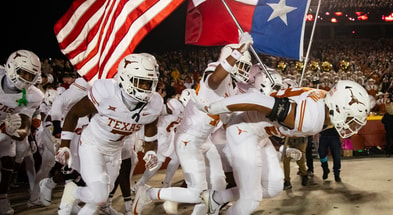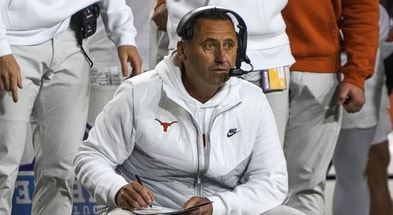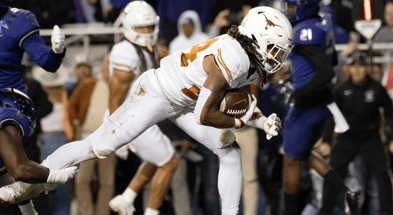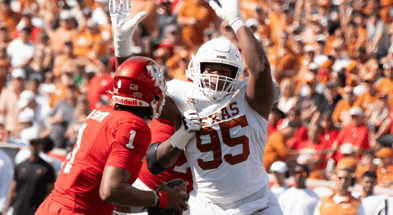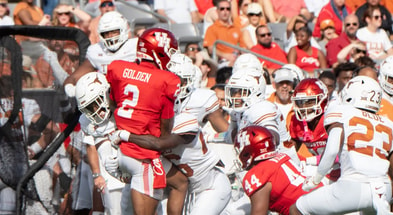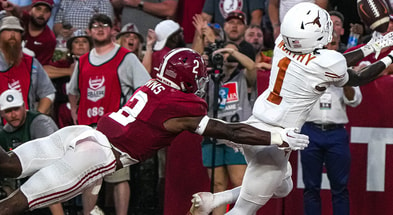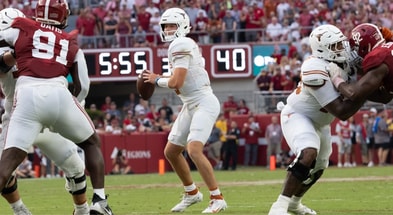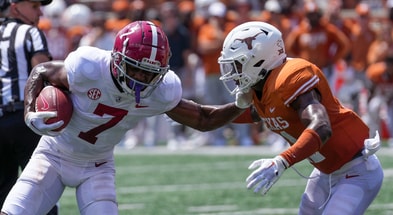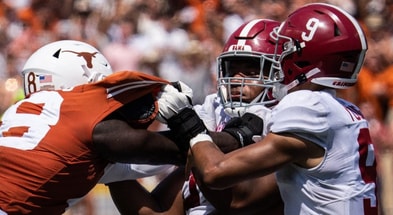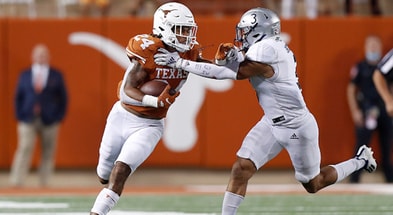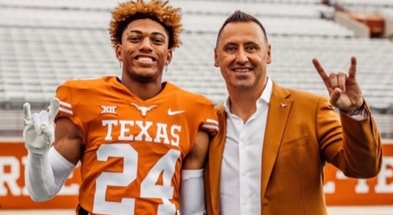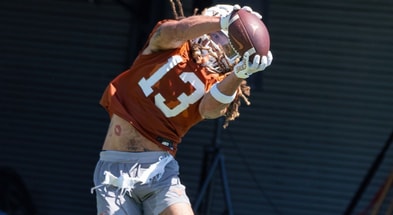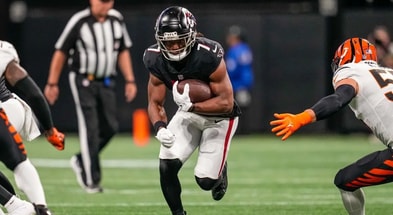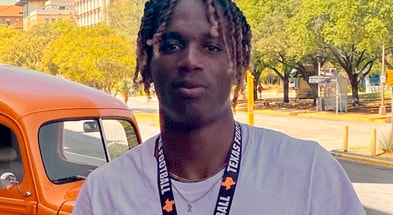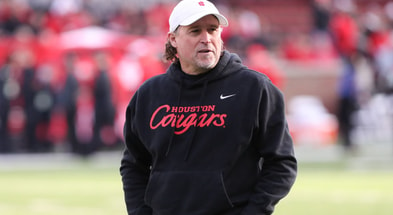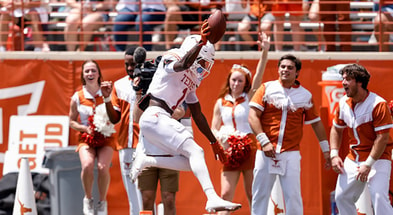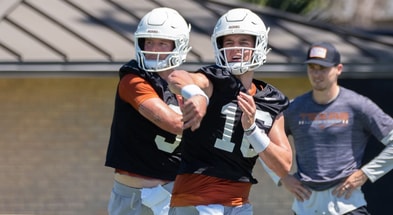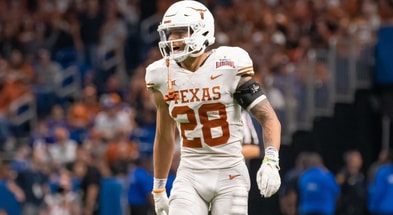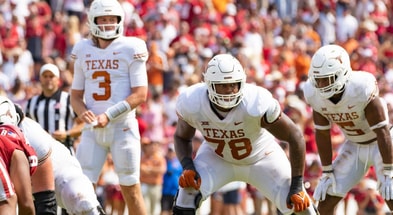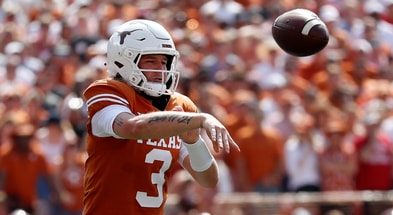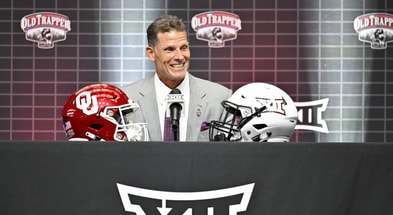Inside the Gameplan: How Orlando will feature Malik

(Alternative title, Predator II)
Last May we discussed how Texas could “build around the Predator” and feature Malik as a main component to the defense. That all came crashing down when Texas didn’t get effective run defense out of the hybrid middle linebacker (or any other LB on campus) and the area where Malik eventually brought value to the team was not one we foresaw. That was his role as a spy while Texas rushed three and played two-deep, man-under coverage to shut down spread passing attacks like what Texas Tech brought against them.
Malik’s ability to play with the range of a safety in coverage didn’t come up too often, his pass-rushing held some value but still wasn’t fully weaponized, and he was too unsound to serve as an eraser in run defense and too unschooled to be an effective freelancer.
After the year was done he had put together the following resume as a two-year starter:
2016: 62 tackles (third on the team), 8.5 tackles for loss (third), 5.5 sacks (second), three pass break-ups (tied for fifth).
2015: 61 tackles (second on the team), seven tackles for loss (fourth), 2.5 sacks (tied for sixth), three pass break-ups (tied for fourth).
Basically he got home to the QB a little more often in his second year then in the first and that’s about it. He didn’t grow enough as a player to anchor a flawed Texas defense and while his freakish athleticism still makes him very interesting to NFL scouts he hasn’t yet put together a season that shows he’s learned how to harness his athleticism in a featured role on defense.
We’ve now learned that Todd Orlando’s plan for the 2017 Texas defense involves Malik playing the “Rover” position, which is what they call their weakside linebacker position but it’s also a bit of a hybrid spot. Here’s how it works…
The Rover in Orlando’s 3-4
The key detail of the 3-4 defense, as many of you that grew up watching football in the 90’s and 00’s probably already understand, is that you can put two star edge-rushers on the field at the same time like in a 4-3 but the offense has a lot less clarity on when and where they are coming.
What’s more, because they aren’t positioned down on the line with their hands in the dirt, they might not only be blitzing on a given play but they might also be stunting into an interior gap. It was a very effective pass defense and was a major component to the Dick LeBeau “zone blitz” defenses that dominated at Pittsburgh in the NFL:
Then along came the spread offense with three receiver sets and eventually even four and five receiver sets that made it harder for 250 pound edge rushers to credibly pose as threats to either drop back in coverage or blitz the edge. College football’s wider field and boundary hash marks only exacerbated this issue and left teams that wanted to get two edge rushers out there in a major bind:
That outside linebacker (“B”) on the boundary might still be in credible position to threaten blitz or not but the guy to the field (“F”) is in a precarious position. He needs to cover a lot of ground to come on a blitz and if he’s a 250 pound edge-rusher he’s probably getting isolated and destroyed in coverage every time he isn’t blitzing.
The typical solution here was for the 3-4 defenses to sub in a nickel defensive back for that outside linebacker aligned to the field, but now if you want a second featured pass-rusher up front where does he go?
The obvious solution is one of those two inside LB spots and that’s exactly what Strong and his staff did and what Orlando will do in 2017. Strong and Bedford put Malik at the middle linebacker spot, which against a trips (three WRs to one side) formation like the one above, is basically like an opposite OLB position to the B-backer (or Fox, Buck, Jack, whatever you wanna call it). Orlando has another plan, he’s going to put Malik on the same side of the field as his other OLB/edge rusher in the Rover position:
Now obviously Orlando will still bring pressure from the opposite end of the field as his B-backer (his traditional OLB/edge-rusher position) but combining the B-backer and Rover to the same side of the field as the two main rushers allows for some interesting tactics up front.
Here’s a glimpse into the kind of production that Orlando has seen from this approach:
It has to be noted that Fackrell was injured early in 2014, so the B-backer didn’t feature a steady figure and Nick Vigil even spent some time there. Similarly, in Houston Tyus Bowser only played in eight games in 2016. I mention this or else you’d think that the Rover was the featured pass-rushing position because of the tremendous stats that players at that spot have put up in Orlando’s defense over the last four years.
The reason Orlando pairs his two main pass-rushers to the same side of the field is that it creates a similar effect to the old 3-4 against non-spread offenses. You don’t know which one is going to do what, but even worse for the offense, the same guy might be responsible for blocking both of them.
One easy way that Orlando would utilize that advantage was with blitzes in which the B-backer would drop back into the Rover’s coverage assignment, the DE next to the B-backer would work outside, and the Rover would look for a lane to charge through up the middle.
http://www.giphy.com/gifs/3og0INMYGsP8zomPu0
As you see on this example against Oklahoma, the LT goes for Bowser and ends up blocking no one. RB Joe Mixon barely manages to pick up Taylor and hold him off long enough for Mayfield to throw the ball and even then Taylor got a lick in and hit his arm.
Any time you can get pressure up the middle with four against a six-man protection, you’re doing good. Of course this requires that the B-backer be capable when dropping into coverage, which should help reveal why Naashon Hughes is currently pencilled in as the no. 1 guy at that spot (we’ll see what happens when pads come on, of course).
Another blitz that makes the most of having both of your top pass-rushers aligned to the same side of the field is every team’s favorite edge pressure:
This is a great anti-spread blitz and Orlando uses it frequently on either side of the formation. Beyond the way in which it overloads the tackle on the edge by making him pass the DE inside before then facing the team’s two best pass-rushers both coming at him, it’s a great option-beater.
If the QB is reading the B-backer on a zone-read play, he’s going to get a keep read by the way “B” dives inside after the RB, but that only leads the QB to keep the ball and try to win the edge against the Rover. In this case Malik Jefferson…which makes you hope that Big 12 teams will run a lot of zone read next season.
Top 10
- 1
SEC victory lap
Super Bowl billboards a bold touch
- 2New
Greg Sankey
Calls for CFP change
- 3
Ryan Day picks OC
Brian Hartline promoted at Ohio State
- 4Hot
Brian Kelly responds
Greg Brooks Jr. allegation amid lawsuit
- 5
Jalen Milroe
'You don't ask a zebra to be a dog'
Get the On3 Top 10 to your inbox every morning
By clicking "Subscribe to Newsletter", I agree to On3's Privacy Notice, Terms, and use of my personal information described therein.
Here’s how it looks live:
http://www.giphy.com/gifs/xUA7bjI7jFonpZd2ow
In this version of the blitz Houston is playing in dime personnel and they blitz the safety where the B-backer would be blitzing, but the goal is the same. They get Taylor free on the outside by overloading the LTs circuits.
When you watch Houston you’ll see Taylor doing normal linebacker things about 70% of the time and blitzing on the other snaps. When you consider his 18.5 sacks in two years in light of judiciously he was blitzing you realize how efficient Orlando can be with a strong rusher at this position.
If you were looking for the ideal position in the Orlando D to unleash Texas’ most explosive and versatile linebacker it would be this one. The fact that Malik is here tells you what the staff thinks of his importance to this season.
Malik’s fit at the Rover position
Texas had two big problems unleashing Malik as a hybrid pass-rusher/inside-backer in the Strong defense. The first was Malik’s own inconsistency as a pass-rusher. As we all became increasingly aware over the course of the last two seasons, Malik had a tendency to stop and reevaluate when he encountered OL in his blitz path rather than taking on their blocks with aggression. This came up a lot when he’d blitz interior gaps like Orlando’s D regularly asks of the Rover.
However, after his triumph against Texas Tech he started to play with more confidence in every regard, including on his interior insert blitzes:
http://www.giphy.com/gifs/3o7bueFBkaRNd8Yb8A
The other problem that Texas encountered was holding up when Malik wasn’t around at the second level to take away hot routes or make tackles against the run. It’s even possible that a lack of trust in his teammates was partially to blame for his occasional tendency to stop and look for the ball if his blitz didn’t find immediate success.
The whole structure of the “zone blitz” defense depends on those three underneath droppers forcing the QB to a second read and not getting gashed by runs. When Malik is blitzing those three underneath droppers are going to come from the pool of the other linebackers, the safeties, and the nickel. For Texas the boundary safety and other inside-backer have been the sore spots in this equation, particularly in run defense. In 2015 that was Peter Jinkens and then either Jason Hall or Dylan Haines. In 2016 it was Hall, Haines, and then an assortment of other players but usually Anthony Wheeler.
In 2017 the current depth chart features John Bonney and Breckyn Hager as the other two guys defending the seams and shallow middle. Bonney is a fantastic fit here in terms of taking away quick easy throws but needs to prove himself in the run-stuffing department. Hager needs to prove he has the lateral range to do either or else he could lose out this job to Gary Johnson in the fall or perhaps even Ed Freeman or Anthony Wheeler this spring.
Another dimension to watch for here is Malik’s growth in run defense and playing coverage underneath. His physical skill set as a linebacker is comparable to NFL-bound hybrid backers like Myles Jack of UCLA and Jaylon Smith of Notre Dame but his mental approach to the game is entirely different.
Despite measuring 6’1” 245 pounds, Myles Jack only had 15 TFL and one sack in 29 games at UCLA. However he also had 19 pass break-ups and four INTs in that same period because Jack tended to use his athleticism to cover grass on the back end. In the NFL game where defending the pass is everything, he factors in as a matchup-proof coverage defender and that was where he developed skills to maximize his athleticism.
Jaylon Smith is nearly identical in size to Malik at 6’2” 235 pounds but he had only 23.5 TFL and 4.5 sacks in 38 games at Notre Dame. He also added 10 pass break-ups and, like Jack, tended to use his athleticism to cover things up on the back end in coverage or running down backs rather than attacking the backfield.
Despite his occasional lack of aggression and physicality in taking on blockers, Malik is actually a vastly more aggressive player than either Jack or Smith. He loves to use his explosiveness and speed to make plays in the backfield. In just 22 games he has as many TFL as Jack and more sacks than either him or Smith and that’s partly due to the way he sniffs out chances to run under blocks and run things down from behind.
The key has always been Malik adding the skills and understanding of when and where to be aggressive and when to be sound and look to cover for his teammates. There have been times when he’s gotten those two considerations exactly wrong in his play.
In year three the Predator is going to be kept in position to attack the backfield from various alignments, the key is whether Orlando can teach him the skills and confidence to put it all together in a way that fits the team concept. If that happens, you can expect the NFL to come calling.








